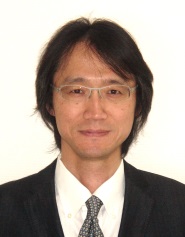
RIES
Research Institute for Electronic Science, Hokkaido University
北海道大学
電子科学研究所

LAST UPDATE 2017/02/25
-
研究者氏名
Researcher Name居城邦治 Kuniharu IJIRO
教授 Professor -
所属
Affiliation北海道大学 電子科学研究所
生命科学研究部門・生体分子デバイス研究分野
Research Institute for Electronic Science, Hokkaido University
Section of Biology and Life Sciences, Laboratory of Molecular Devices -
研究キーワード
Research KeywordsDNA ミメティクス
自己組織化
ボトムアップナノファブリケーション
DNA mimetics
Self-assembly
Bottom-up nanofabrication
- 研究テーマ
Research Subject -
生体模倣による自己組織化ナノファブリケーション技術の開発
Development of nanofabrication method based on biomimetic self-assembly
研究の背景 Background of the Research
高度情報通信社会を将来にわたって持続的に発展させるためには、電子デバイスの微細化と高性能化を低コストでさらに進めなければなりませんが、従来のトップダウンプロセスの延長線上では実現が困難であり、それに代わる新しいナノデバイス作製技術の開発が求められています。そこで、トップダウンプロセスの限界を補う期待されるボトムアッププロセスとしての鋳型誘導自己組織化に注目が集まっています。
The development of advanced information society rewires various kinds of electronic devices with high performance produced by low-cost nanofabrication. Self-assembly is referred to as a 'bottom-up' manufacturing technique in contrast to a 'top-down' technique such as lithography. Continued advances in templated self-assembly have led to the generation of highly controllable conductive nanowires as nanoscale circuits with potential applications in nanoelectronics that were previously difficult to produce through top-down methods.
研究の目標 Research Objective
生物は高度な分子認識とそれによって組織化された分子集合体システムを駆使して、効率の良いエネルギー変換や物質生産、情報変換を達成しています。生体材料を鋳型に用いた自己組織化をボトムアッププロセスに応用することで新規な分析手法の開発、分子素子や機能性材料の構築をめざします。具体的には、DNAの持つ分子メモリー機能、分子認識、自己会合性を自己組織化に利用することで、機能性ナノワイヤーの構築を行います。
Bioorganisms are capable of efficient energy transformation, selective synthesis of biomolecules and interactive information processing. All these processes are based on effective self-assembly of molecules. Of the many templates available, DNA behaves as an insulator, while offering the advantages of a well-defined linear structure, sequence programmability, and rich chemical functionality. These properties have allowed the DNA-templated assembly of a wide variety of materials of interest.
研究図Figures

論文発表 / Publications
ACS Appl. Nano Mater., 8, 10321 (2022)., Nano Today, 39, 101154 (2021)., J. Mater. Chem. B., 1, 5899 (2013).
研究者連絡先 / HP
- ijiro
 es.hokudai.ac.jp
es.hokudai.ac.jp - https://chem.es.hokudai.ac.jp/